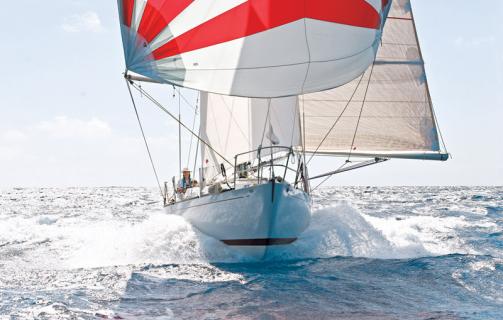Doublehanded Crew Overboard Practices
Chuck Hawley, San Francisco Station, with immense help from
Stan Honey and Sally Lindsay Honey, San Francisco Station
Different boats, especially as startlingly different as the 100’ Comanche, may have to modify the standard techniques for various safety maneuvers. CCA Members Stan and Sally Honey, among the most successful CCA racers on their Cal 40 Illusion, have thought long and hard about the best way to get one another back on board after an overboard incident. They’re quick to point out that all COB methods may have to be customized for different boats, the number of crew (please, God, let it be more than one...) and the skill level of the sailors.
With those caveats in mind, here is the Station Bill for a doublehanded COB incident on Illusion:
Push the MOB button
- Slow the boat down by heading up or down, as appropriate for the point of sail.
- Take the time to do the following carefully and properly. If sails get fouled in the rigging and can’t be dropped, or if lines get in the prop, the MOB is toast.
- Sock the spinnaker or furl the headsail.
- If the AIS MOB beacon is visible on the chart plotter use that range/bearing instead of the location where the MOB button was pressed.
- Sail by the MOB close aboard under mainsail and drop the JonBuoy and Type 4s right at the MOB to make sure that the MOB has flotation. Don’t stop. Sail some distance away to avoid the possibility of the boat drifting over the MOB.
- Check for lines overboard.
- Start the engine and power slowly upwind under autopilot.
- If the engine is working, drop the main.
- Deploy and tow the Lifesling.
- Circle the MOB motoring slowly. As usual in water skiing, don’t motor over the floating Lifesling line.
- When the MOB has the Lifesling, stop the boat someplace where it won’t drift over the MOB, engine in neutral or stopped, helm hard over, and let the boat drift, slowly towing the MOB from the stern at the end of the Lifesling line.
- Hook the spinnaker halyard to the bight of the Lifesling line, outboard of the lifelines.
- Hoist. The MOB will end up being hoisted outboard of the shrouds.
Comments from Stan and Sally:
The above requires the Lifesling line to be shorter than 2x the mast-height and requires the spinnaker halyard to be long enough to reach the stern. It appears in trials that even with a 1:2, and with the sort of geared halyard winches that are found on >=35 foot boats, small sailors can hoist a MOB over the rail.
Even if the sailor onboard can’t get the MOB entirely over the rail, the MOB will be hoisted head and shoulders above the water next to the boat and the boat won’t drift over them. The sailor onboard would then have time to connect a 1:1 halyard, or a tackle on a halyard.
The extra-long spinnaker halyard may also be useful for recovering a person dragging overboard on a tether using a similar technique. To recover a sailor attached by a tether: slow the boat, hook the halyard to the bight of the tether outboard of the lifelines, hoist. Robin Knox-Johnston states that this approach has worked best in the Clipper and has been used several times.
Comments from Chuck:
- This may seem to have a lot of steps (the method on the Lifesling bag has but six panels), but if it is practiced and documented, the number of steps is probably irrelevant.
- Successful completion without disabling the boat is more important than speeding through the process. A line in the propeller or a sail around the keel would be difficult to recover from.
- A crew overboard beacon (either AIS or AIS/DSC) reduces the absolute necessity to stay within visual contact of the PIW. It’s easy to imagine that dropping a reluctant spinnaker could take you ¼ mile from the PIW. Without a beacon that transmits updated position information, you’re too dependent on luck as to whether you find the person.
- Stan and Sally recommend the “Comanche 1:2” retrieval method. This requires a large self-tailing winch. It’s also fundamentally different from how we may have been taught to pull someone to the boat and aboard. This is an excellent reason for a yacht club or sailing organization practice day so that everyone gets a chance to try the method.
The Cruising Club of America is a collection of passionate, seriously accomplished, ocean sailors making adventurous use of the seas. All members have extensive offshore boat handling, seamanship, and command experience honed over many years. “School of Hard Rocks” stories, published by the CCA Safety and Seamanship Committee, are intended to advance seamanship and help skippers promote a Culture of Safety aboard their vessels.






